Proactive Project Management: Enhancing Project Follow-up with 30 Letter Templates
Welcome to our comprehensive guide on Project Follow-up Letters. In the dynamic world of project management, effective communication and timely follow-up are crucial for ensuring project success. Project follow-up letters serve as powerful communication tools that help project managers maintain open lines of communication, provide updates, address concerns, and gather feedback from stakeholders. Whether you’re looking to summarize project outcomes, evaluate performance, address delays, or express gratitude, our guide will provide you with valuable insights and sample templates to craft impactful follow-up letters. By leveraging these letters, you can strengthen stakeholder relationships, promote collaboration, and drive project success. Join us as we explore various types of project follow-up letters and discover best practices for their implementation.
Project Impact and Benefits Realization
Project Impact and Benefits Realization is a crucial aspect of project follow-up letters. It involves assessing and communicating the overall impact and outcomes of the project, specifically focusing on the benefits that have been realized by stakeholders and the organization. Here are some key points to consider:
- Benefits Identification: Clearly identify and define the expected benefits or outcomes of the project. This includes both tangible and intangible benefits, such as increased revenue, cost savings, improved customer satisfaction, enhanced efficiency, or strategic advantages.
- Benefit Measurement: Develop a framework or methodology to measure and quantify the achieved benefits. This may involve conducting post-project assessments, analyzing performance indicators, or collecting feedback from stakeholders to evaluate the extent to which the project has delivered the intended outcomes.
- Stakeholder Engagement: Engage with stakeholders to gather their perspectives on the impact of the project. Conduct surveys, interviews, or focus groups to capture their feedback and experiences regarding the realized benefits. This helps in validating the project’s impact and identifying areas for improvement.
- Benefits Communication: Prepare a comprehensive report or summary that highlights the project’s impact and the benefits realized. This report should clearly articulate the achieved outcomes, the value created, and the positive changes brought about by the project. Use data, case studies, and testimonials to support the findings and make the communication more compelling.
- Lessons Learned: Reflect on the project’s impact and benefits to identify key lessons learned. Document these lessons and share them with relevant stakeholders, including project teams, management, and future project teams. Lessons learned can inform future decision-making and contribute to continuous improvement in project management practices.
- Continuous Monitoring: Establish mechanisms for ongoing monitoring and evaluation of the project’s impact and benefits. This ensures that the achieved outcomes are sustained and that any potential risks or challenges are addressed proactively. Regularly review and update the benefits realization plan to adapt to changing circumstances.
#1: Project Completion Follow-up Letter:
A letter is sent after the project has been completed to summarize the outcomes, express gratitude, and discuss any remaining tasks or next steps. The Project Completion Follow-up Letter serves as a formal communication after the successful completion of a project. Its primary purpose is to provide a concise summary of the project’s outcomes, express gratitude to the project team, clients, and stakeholders, and discuss any remaining tasks or next steps. This letter ensures that all parties involved are aware of the project’s final status, highlights key achievements, and fosters a sense of closure and appreciation. Additionally, it serves as an opportunity to address any pending matters, such as follow-up tasks or future project opportunities.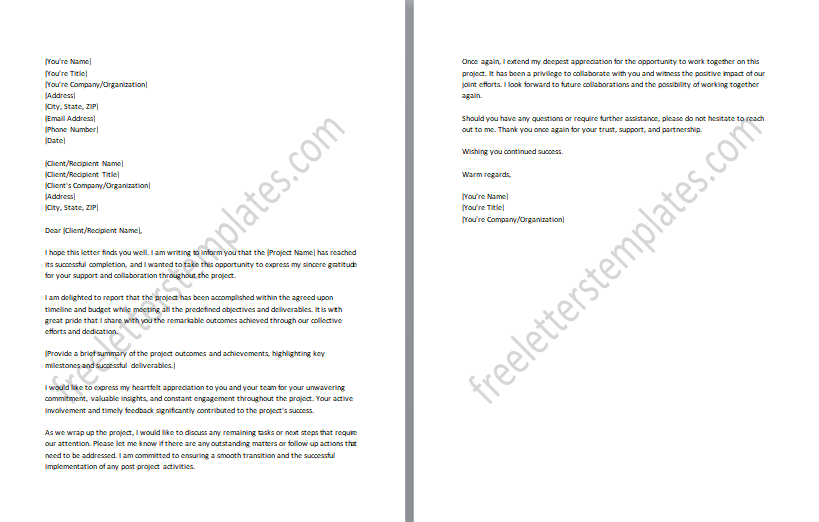
#2: Project Evaluation Follow-up Communication:
A communication is sent to evaluate the project’s performance, gather feedback from stakeholders, and identify areas for improvement. The Project Evaluation Follow-up Communication is a formal communication sent to assess the performance of a project, gather valuable feedback from stakeholders, and identify areas for improvement. Its purpose is to conduct a comprehensive evaluation of the project, analyzing its success in meeting objectives, efficiency in resource utilization, and overall stakeholder satisfaction. This communication serves as a means to gather insights, suggestions, and recommendations from stakeholders, enabling the project team to gain valuable perspectives and identify opportunities for enhancing future projects. It promotes a culture of continuous improvement and ensures that lessons learned from the project are applied to future endeavors.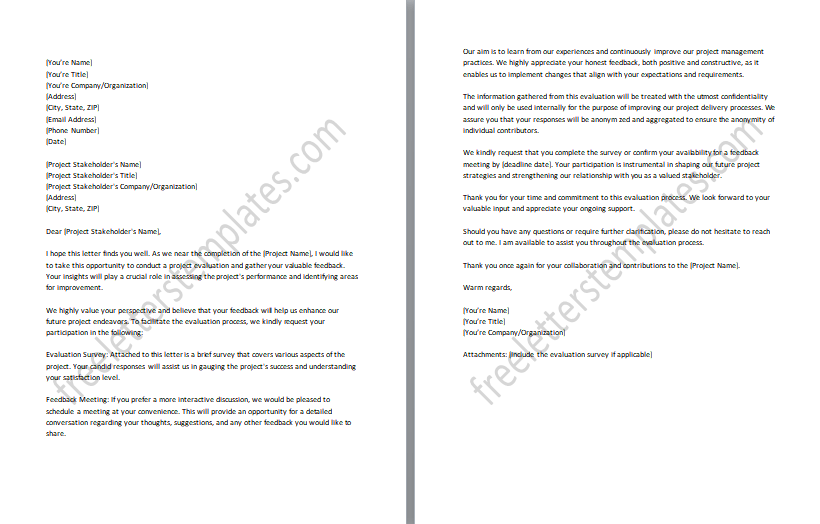
#3: Project Progress Status Update:
A letter providing an update on the project’s progress, highlighting achievements, and addressing any concerns or challenges. The Project Progress Status Update letter is designed to provide stakeholders with a comprehensive update on the project’s progress. This letter serves as a transparent and proactive means of communication, ensuring that stakeholders are aware of the project’s progress, milestones achieved, and potential obstacles encountered. It fosters open dialogue, allows for the timely resolution of issues, and reassures stakeholders of the project’s continued advancement toward its goals.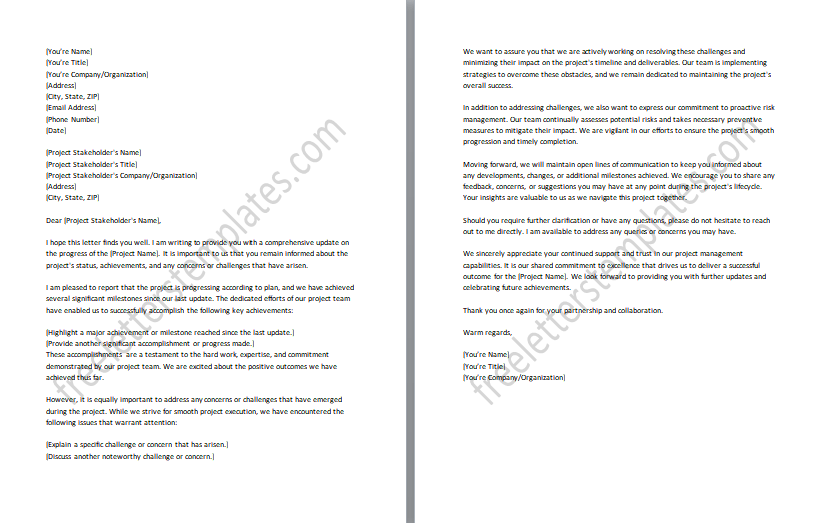
#4: Milestone Check-in for the Project:
A letter focusing on specific project milestones, discussing their successful completion, and outlining the upcoming milestones or tasks. The Milestone Check-in for the Project letter is a focused communication that centers around specific project milestones. Its purpose is to provide an update on the successful completion of these milestones and to outline the upcoming milestones or tasks that lie ahead. By highlighting the achievements of past milestones, this letter acknowledges the progress made and instills a sense of accomplishment. It also serves as a roadmap for the future, informing stakeholders about the next set of objectives and tasks to be accomplished.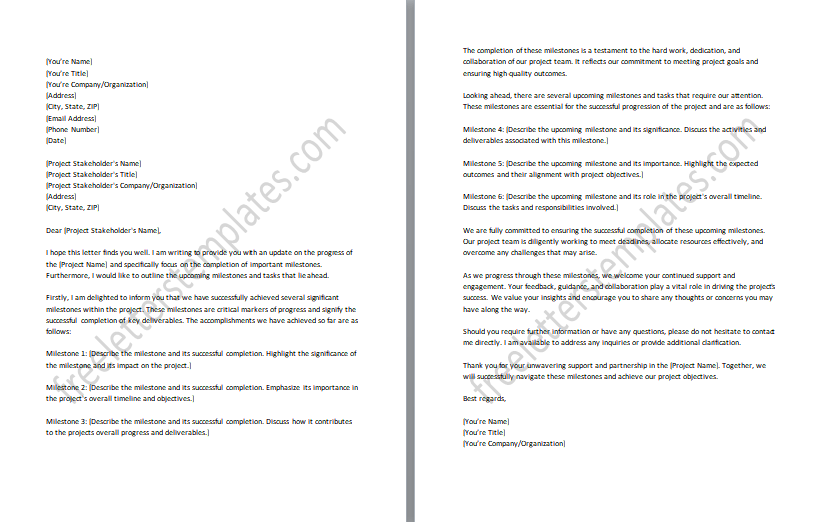
#5: Project Status Follow-up Note:
A concise note was sent to provide a general status update on the project, including key accomplishments and upcoming activities. The Project Status Follow-up Note is a concise communication aimed at providing a general update on the project’s status. Its purpose is to offer stakeholders a snapshot of the project’s progress, key accomplishments, and upcoming activities. This note serves as a brief and informative summary, ensuring that stakeholders are informed about the project’s current state without overwhelming them with excessive details. It allows for efficient communication, keeps stakeholders engaged and informed, and provides a high-level overview of the project’s trajectory. By highlighting both achievements and upcoming activities, this note ensures that stakeholders have a clear understanding of the project’s direction and what to expect shortly.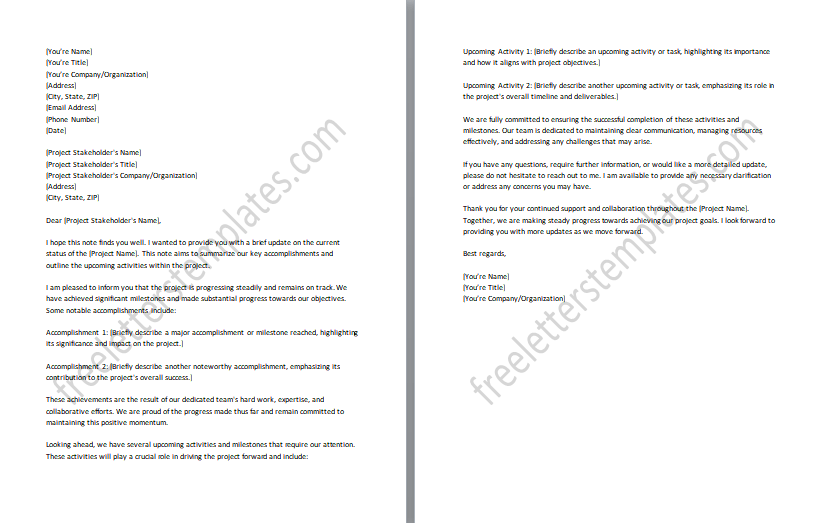
#6: Financial Review of the Project:
A letter reviewing the project’s financial aspects, such as budget utilization, cost analysis, and financial outcomes. The Financial Review of the Project letter presents a concise summary of the project’s financial aspects, including budget utilization, cost analysis, and financial outcomes. It showcases the project’s commitment to sound financial management, highlighting adherence to the allocated budget and efficient resource utilization. The letter provides stakeholders with a clear overview of the project’s financial performance, emphasizing its financial efficiency and adherence to financial goals. By presenting this information transparently and comprehensively, the letter instills confidence and trust among stakeholders, ensuring that they are well informed about the project’s financial status and outcomes.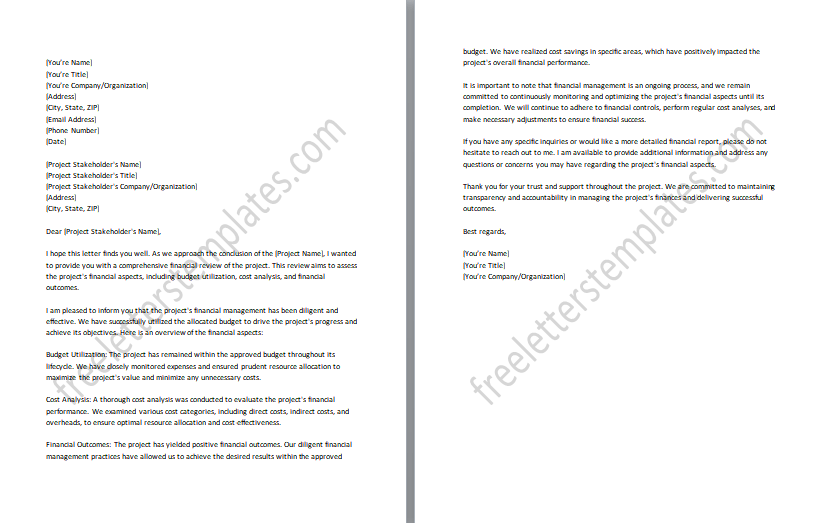
#7: Project Feedback and Recommendations:
A letter soliciting feedback from project stakeholders and offering recommendations for improvement or future projects. The Project Feedback and Recommendations letter serves as a means to gather valuable feedback from project stakeholders while also providing recommendations for improvement or future projects. The letter encourages open dialogue and invites stakeholders to share their insights, experiences, and suggestions related to the project. By actively seeking feedback, the project team demonstrates a commitment to continuous improvement and a desire to enhance future project endeavors. The letter summarizes the purpose of soliciting feedback, acknowledges the importance of stakeholder perspectives, and expresses gratitude for their input.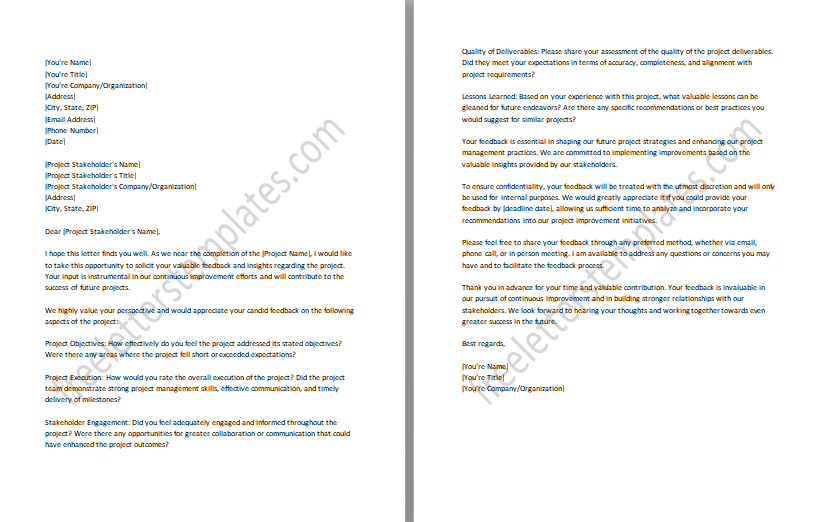
#8: Project Timeline Update and Follow-up:
A letter addressing any changes or updates to the project timeline, discussing the reasons and potential impacts. The Project Timeline Update and Follow-up letter is a crucial communication that addresses any changes or updates to the project timeline. It provides stakeholders with a concise summary of the reasons behind the timeline modifications and discusses the potential impacts on the project. The letter ensures transparency and proactive communication by informing all parties involved about any adjustments made to the project schedule. It emphasizes the importance of keeping stakeholders informed, managing expectations, and minimizing any potential disruptions caused by timeline changes. Through this letter, the project team strives to maintain open lines of communication and collaboration, ensuring that all stakeholders are aligned and prepared for the revised project timeline.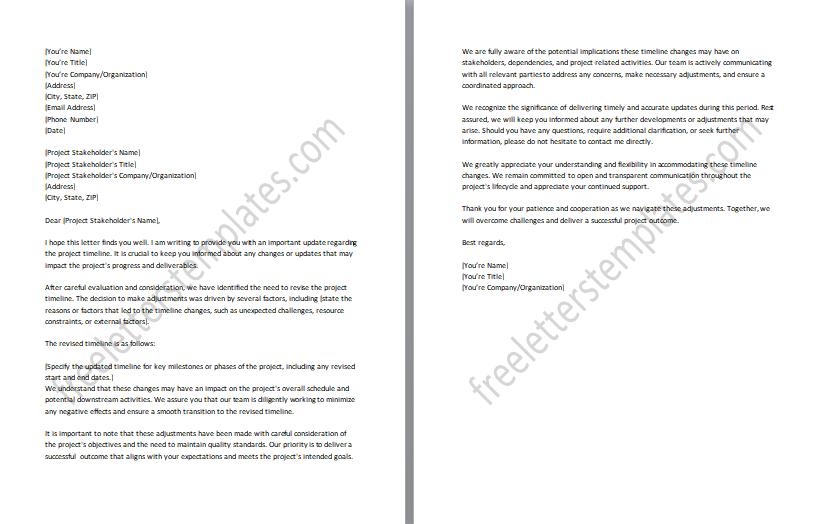
#9: Addressing Project Delays:
A letter acknowledging project delays, providing an explanation, and outlining mitigation strategies or revised timelines. The Addressing Project Delays letter acknowledges and addresses any delays encountered during the project, providing stakeholders with a clear explanation of the situation. It also outlines mitigation strategies or revised timelines to ensure that the project stays on track. The letter emphasizes transparency and accountability, acknowledging the impact of the delays and expressing a commitment to finding solutions.
By addressing the delays promptly and offering potential mitigation strategies or revised timelines, the project team demonstrates a proactive approach to managing challenges. This letter fosters effective communication, manages stakeholder expectations, and reinforces the project team’s dedication to delivering successful outcomes.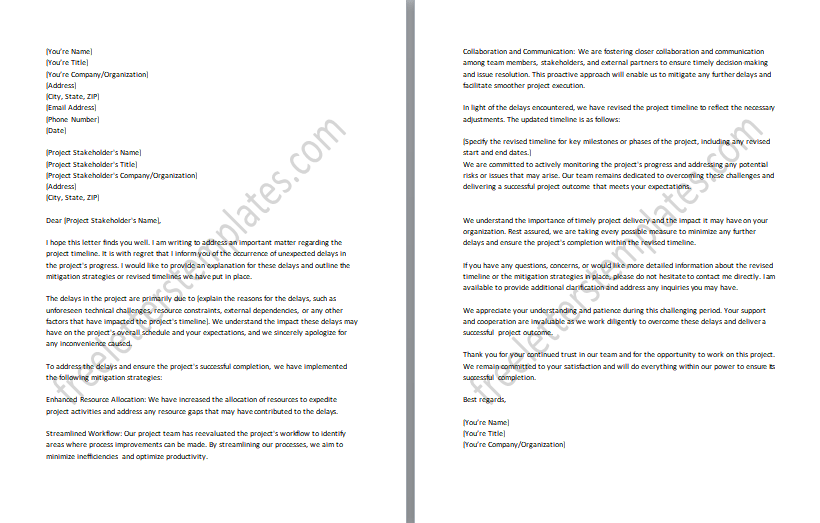
#10: Celebrating Project Success:
A letter dedicated to acknowledging and celebrating the successful completion of the project, expressing appreciation to the team and stakeholders. The Celebrating Project Success letter is a heartfelt communication dedicated to acknowledging and expressing gratitude for the successful completion of the project. It serves as a platform to celebrate achievements and express sincere appreciation to the project team and stakeholders. The letter highlights the collective efforts, hard work, and dedication that contributed to the project’s success. Through this letter, the project team aims to strengthen relationships, boost morale, and create a sense of pride and fulfillment in the shared achievements.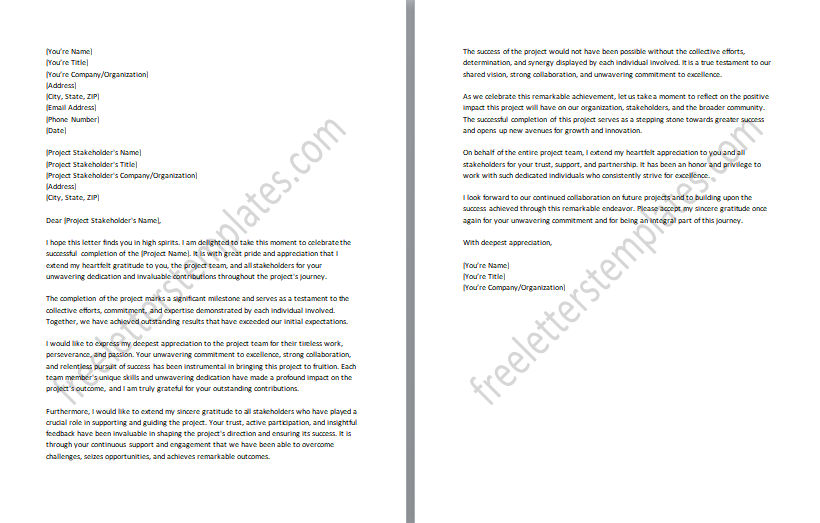
#11: Analysis of Project Setbacks:
A letter analyzing setbacks or challenges encountered during the project, discussing their causes, impact, and lessons learned. The Analysis of Project Setbacks letter serves as a comprehensive analysis of the setbacks or challenges encountered during the project. The letter aims to foster a culture of continuous improvement by acknowledging and understanding the setbacks experienced. It emphasizes the importance of reflection and learning from these challenges to enhance future project outcomes. By openly discussing the setbacks, their causes, and the lessons learned, the letter promotes transparency, accountability, and a proactive approach to addressing obstacles. Through this analysis, the project team can gain valuable insights and develop strategies to mitigate similar challenges in future projects.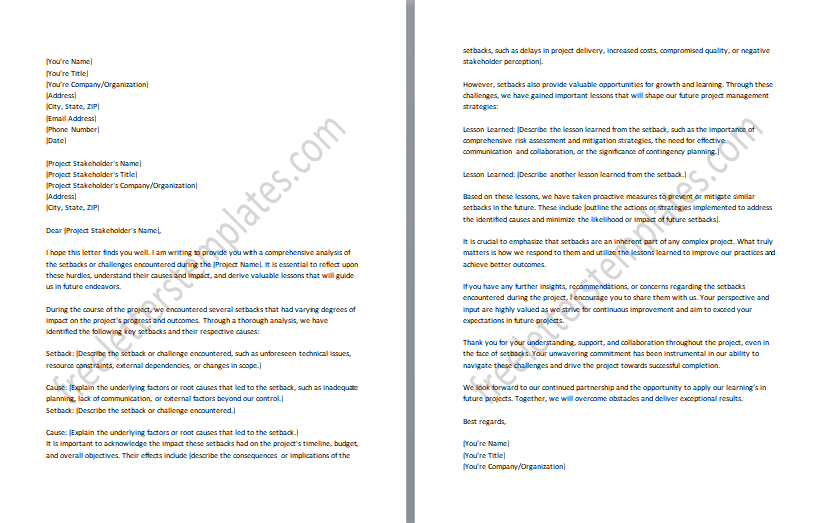
#12: Recap of Project Achievements:
A letter summarizing the project’s major achievements, highlighting milestones, deliverables, and outcomes. The Recap of Project Achievements letter provides a comprehensive summary of the major accomplishments of the project. It highlights key milestones, deliverables, and outcomes that were successfully achieved. This letter serves as a testament to the hard work, dedication, and collaboration of the project team and stakeholders involved. It showcases the progress made, the value delivered, and the positive impact generated by the project. By summarizing the project’s achievements, the letter reinforces the project team’s commitment to excellence and serves as a source of pride and motivation.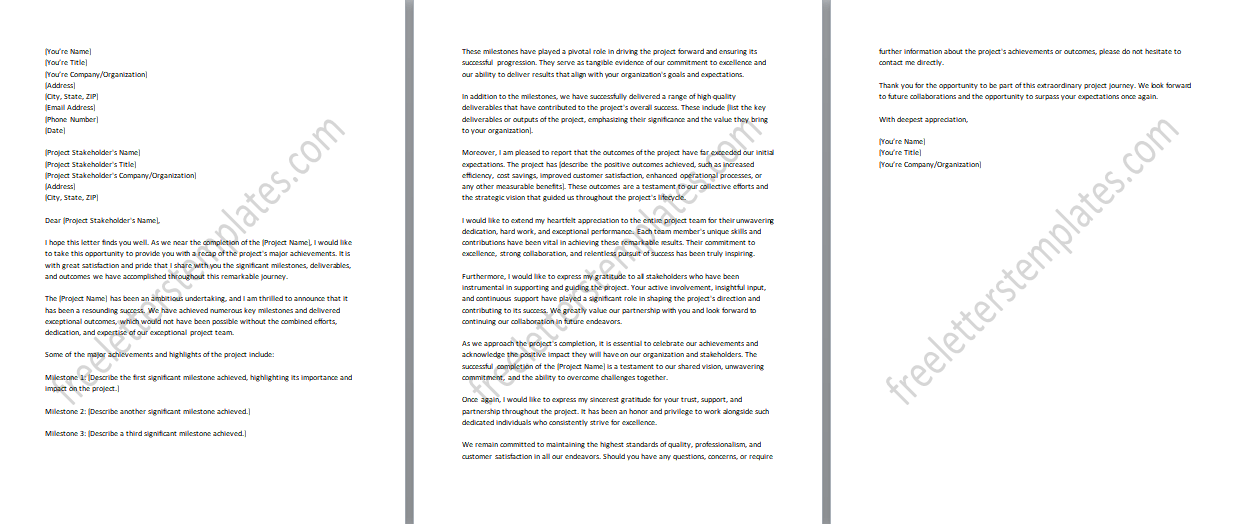
#13: Key Takeaways from the Project:
A letter identifying and discussing the key lessons learned from the project, including insights and best practices. The Key Takeaways from the Project letter provide a concise summary of the essential lessons learned during the project. It serves as a reflection of the insights and best practices gained from the project’s experiences. The letter highlights the value of these takeaways in enhancing future projects and driving continuous improvement. By summarizing the key lessons learned, the letter ensures that the project team and stakeholders have a clear understanding of the knowledge gained and can effectively apply it in future endeavors. It promotes a culture of learning and growth, enabling the organization to build upon its successes and avoid potential pitfalls in future projects.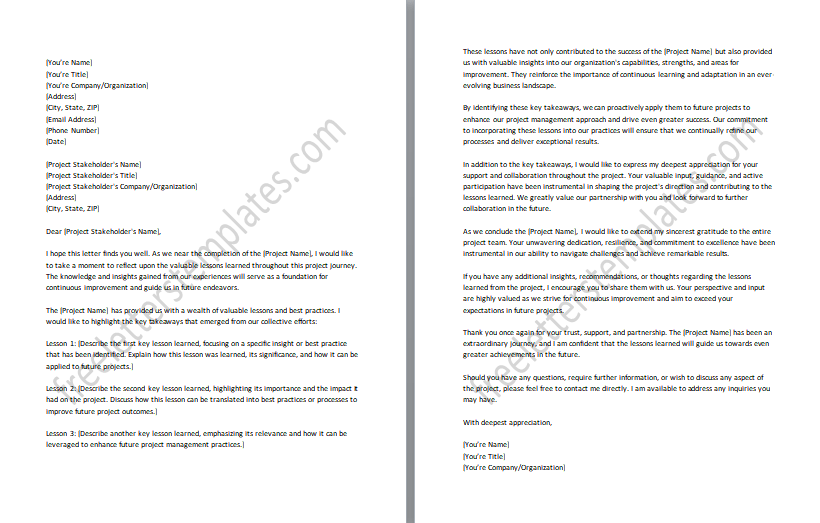
#14: Project Recommendations and Next Steps:
A letter providing recommendations for future projects based on the lessons learned and suggesting the next steps to be taken. The Project Recommendations and Next Steps letter is a comprehensive communication that offers valuable recommendations for future projects based on the lessons learned from the current project. It outlines actionable steps and strategies to enhance project outcomes, efficiency, and effectiveness.
The letter emphasizes the importance of applying the lessons learned to drive continuous improvement and success in future endeavors. By providing practical recommendations and suggesting the next steps to be taken, the letter empowers the project team and stakeholders to implement positive changes and make informed decisions for upcoming projects. It serves as a valuable resource for project planning and execution, ensuring that the organization capitalizes on its learnings and maximizes project success.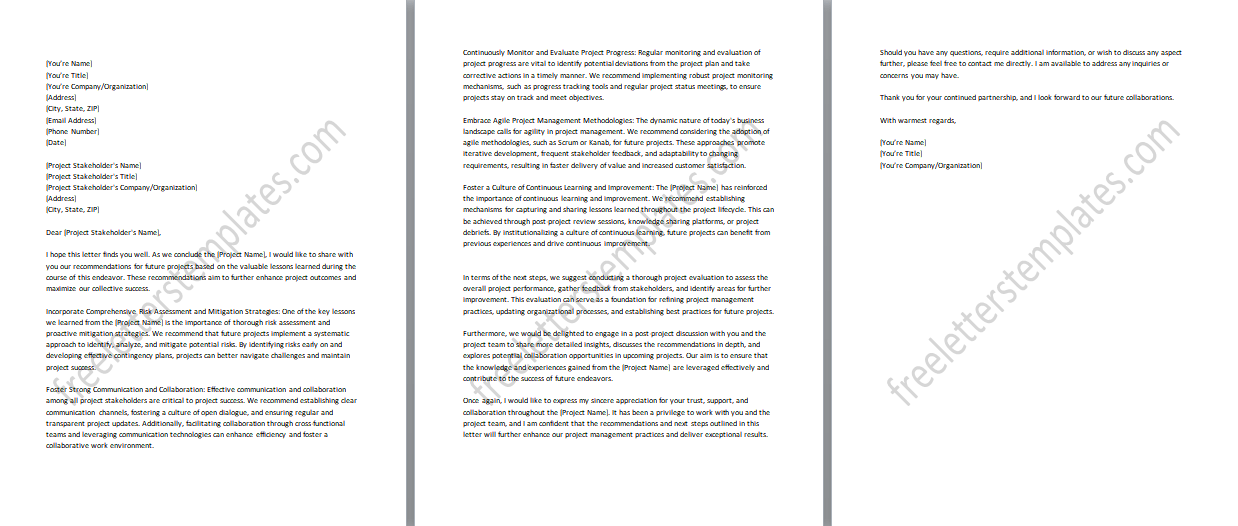
#15: Lessons Learned from the Project:
A letter documenting the project’s lessons learned, capturing insights, and recommending improvements for future projects. The Lessons Learned from the Project letter serves as a valuable document capturing the project’s key takeaways, insights, and recommendations for future projects. It consolidates the knowledge gained throughout the project, highlighting both successful strategies and areas for improvement. The letter provides a concise summary of the lessons learned, ensuring that the organization can leverage these insights to enhance future projects and avoid potential pitfalls. By documenting the lessons learned, the letter promotes a culture of continuous learning and improvement, facilitating the organization’s growth and success in future endeavors.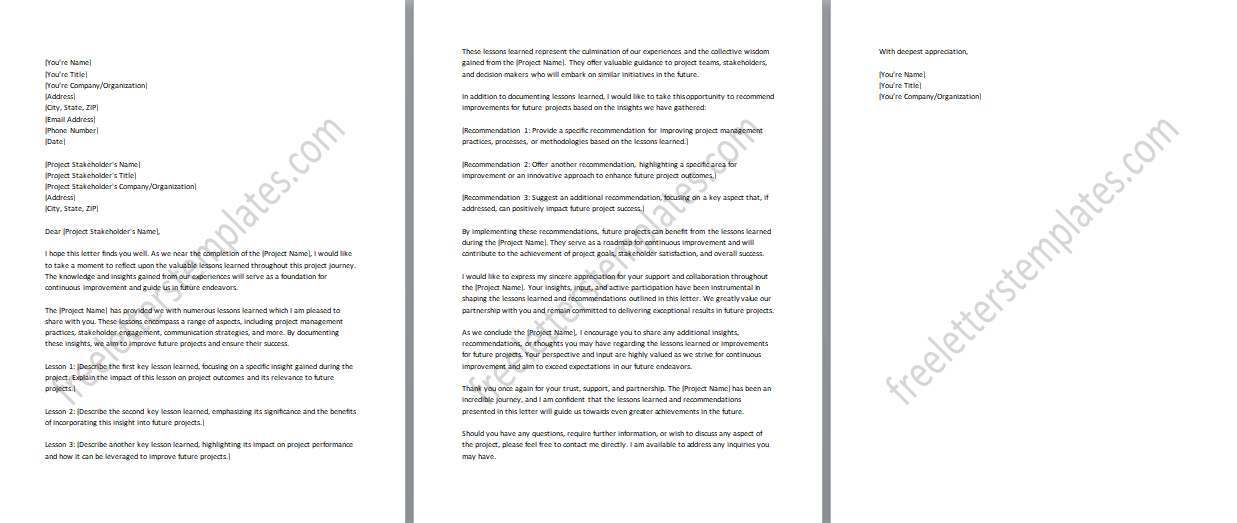
#16: Project Change Request Update:
A letter acknowledging and providing an update on a requested change to the project, discussing the decision and potential impacts. The Project Change Request Update letter acknowledges and provides an update on a requested change to the project. It communicates the decision made regarding the change request and discusses the potential impacts of implementing or rejecting the change. The letter ensures transparency and open communication by addressing the change request in a timely manner. By summarizing the key points of the update, the letter keeps all parties informed and aligned, promoting effective project management and stakeholder engagement.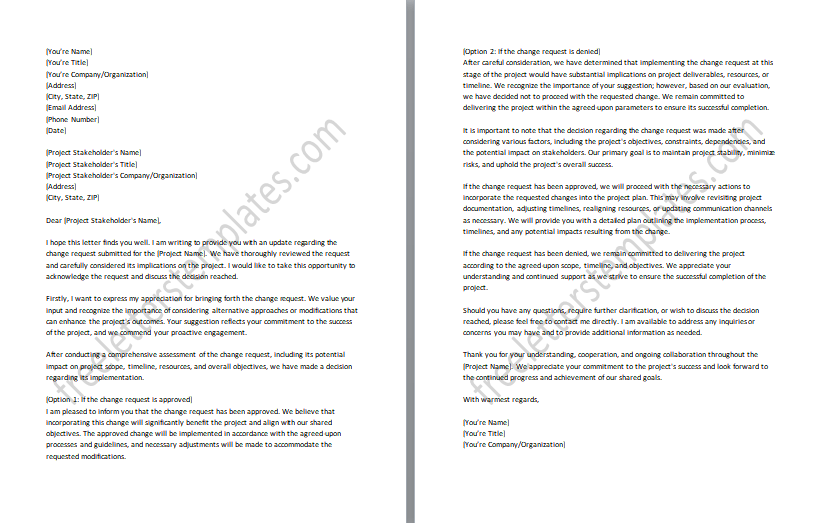
#17: Project Action Plan Follow-up:
A letter following up on the implementation of an action plan, reviewing progress, and addressing any challenges or modifications. The Project Action Plan Follow-up letter serves as a comprehensive communication that follows up on the implementation of an action plan. It provides an overview of the progress made in executing the action plan, reviews the achievements, and addresses any challenges or modifications that may have arisen. The letter emphasizes the importance of tracking and evaluating the progress to ensure the successful completion of the project. By summarizing the key points of the follow-up, the letter keeps all stakeholders informed, facilitates collaboration, and enables timely decision-making to overcome any obstacles.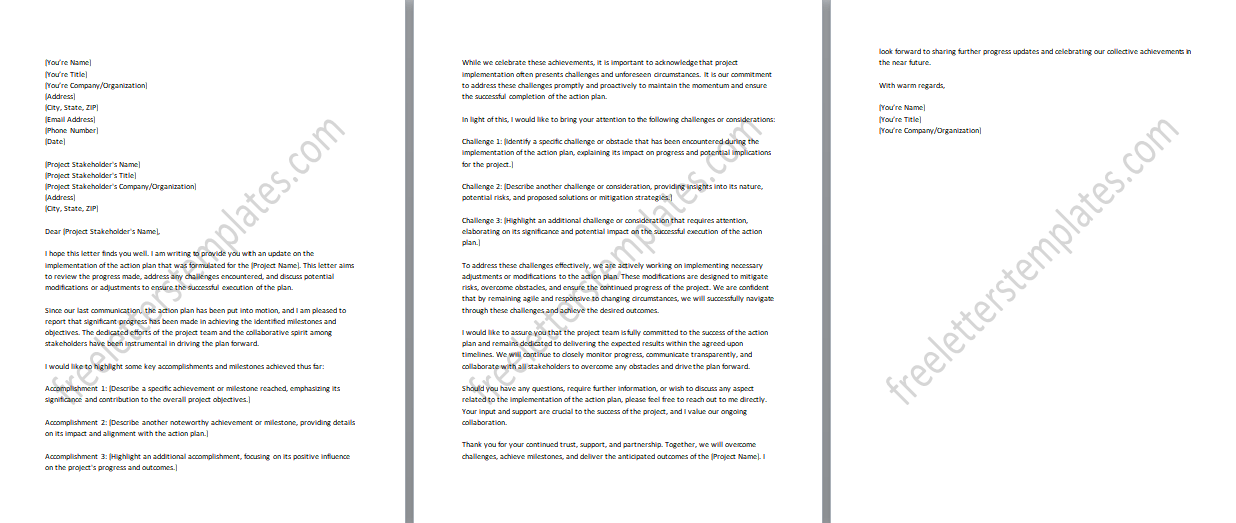
#18: Project Resource Allocation Review:
A letter reviewing the allocation of resources for the project, assessing their effectiveness, and proposing adjustments if necessary. The Project Resource Allocation Review letter provides a detailed assessment of the resource allocation for the project, reviewing the effectiveness of the current allocation and proposing adjustments if necessary. It highlights the importance of aligning resources with project requirements and objectives to maximize efficiency and productivity. The letter evaluates the utilization and impact of resources, considering factors such as budget, manpower, equipment, and time. By summarizing the key findings and recommendations, the letter facilitates informed decision-making and promotes effective resource management. It ensures that the project team and stakeholders are aware of any resource-related challenges or opportunities, allowing for proactive adjustments to enhance project performance and outcomes.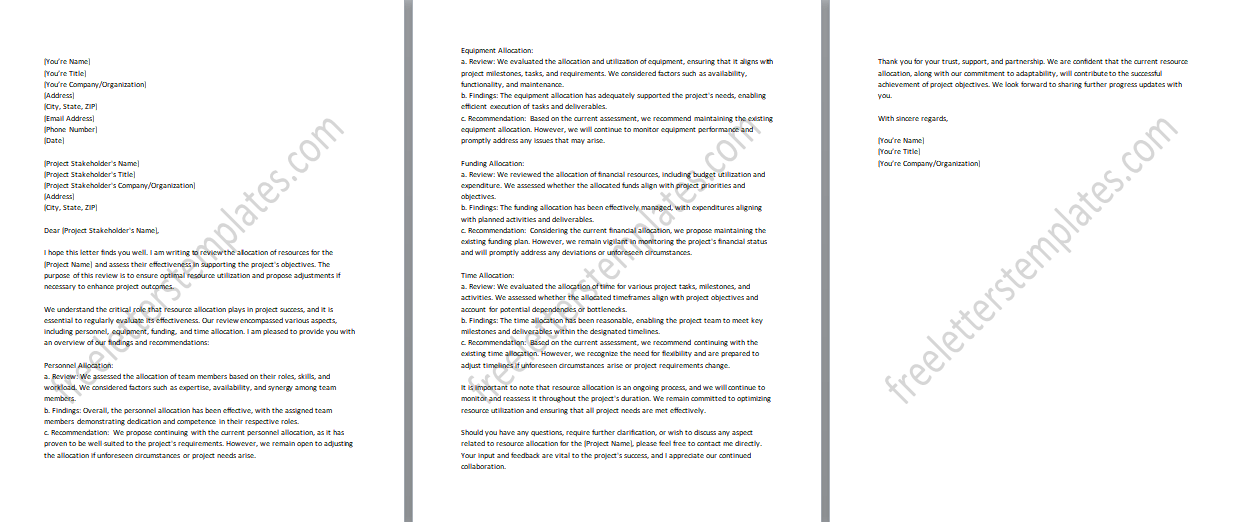
#19: Assessing Risks in the Project:
A letter focusing on the assessment of project risks, discussing mitigation strategies, and highlighting any changes in risk levels. The Assessing Risks in the Project letter provides a comprehensive assessment of the project’s risks, focusing on their evaluation, mitigation strategies, and any changes in risk levels. The letter aims to proactively identify and address potential risks to ensure the project’s success. It highlights the identified risks, their potential impact, and the likelihood of occurrence, as well as the strategies implemented or recommended to mitigate them. By summarizing the key findings, the letter promotes risk awareness among stakeholders, facilitates informed decision-making, and enables proactive risk management. Regular updates on changes in risk levels ensure that the project remains on track and adaptable to evolving circumstances. Overall, the letter emphasizes the importance of risk management and underscores the commitment to safeguarding the project’s objectives.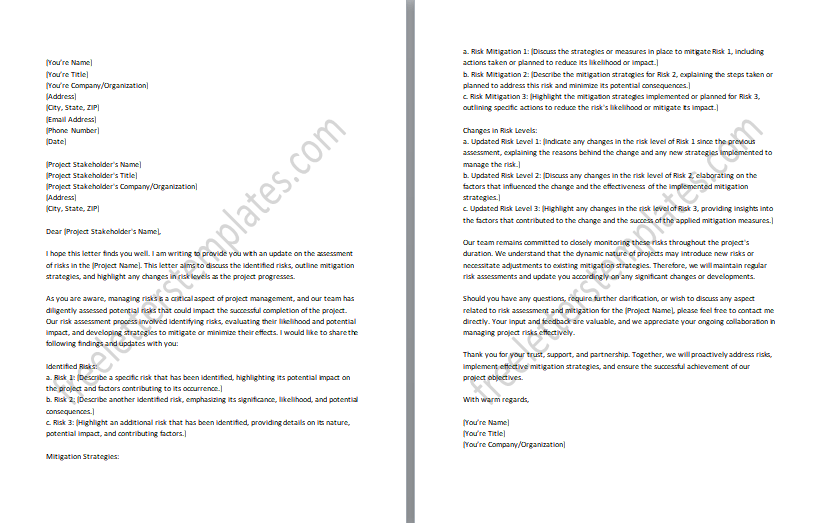
#20: Effective Project Communication Strategies:
A letter emphasizing the importance of effective communication in the project, providing tips, and encouraging open dialogue. The Effective Project Communication Strategies letter emphasizes the importance of effective communication in the project and provides valuable tips and strategies to enhance communication and encourage open dialogue. It highlights the significance of clear communication channels, setting expectations, active listening, using clear language, regular project updates, and fostering a collaborative culture.
By following these strategies, the letter aims to improve project communication, strengthen relationships among stakeholders, and ensure the smooth flow of information throughout the project. It encourages active participation and engagement from all stakeholders to achieve effective communication and ultimately enhance project success.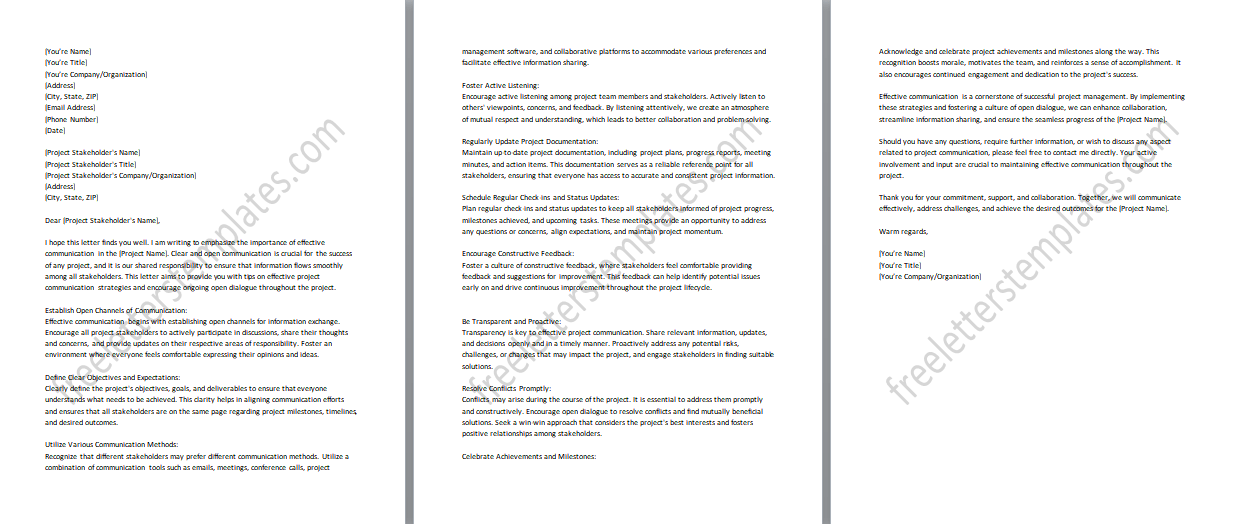
#21: Building a Strong Project Team:
A letter discussing strategies for building a cohesive and high-performing project team, promoting collaboration and synergy. The Building a Strong Project Team letter emphasizes the importance of building a cohesive and high-performing project team. It provides strategies and approaches to promote collaboration, synergy, and a positive team dynamic.
The letter highlights the significance of clearly defining team roles and responsibilities, fostering open communication, encouraging trust and respect among team members, promoting a shared vision and goals, and providing opportunities for professional development and team-building activities. By implementing these strategies, the letter aims to create a strong project team that is motivated, engaged, and capable of delivering outstanding project outcomes.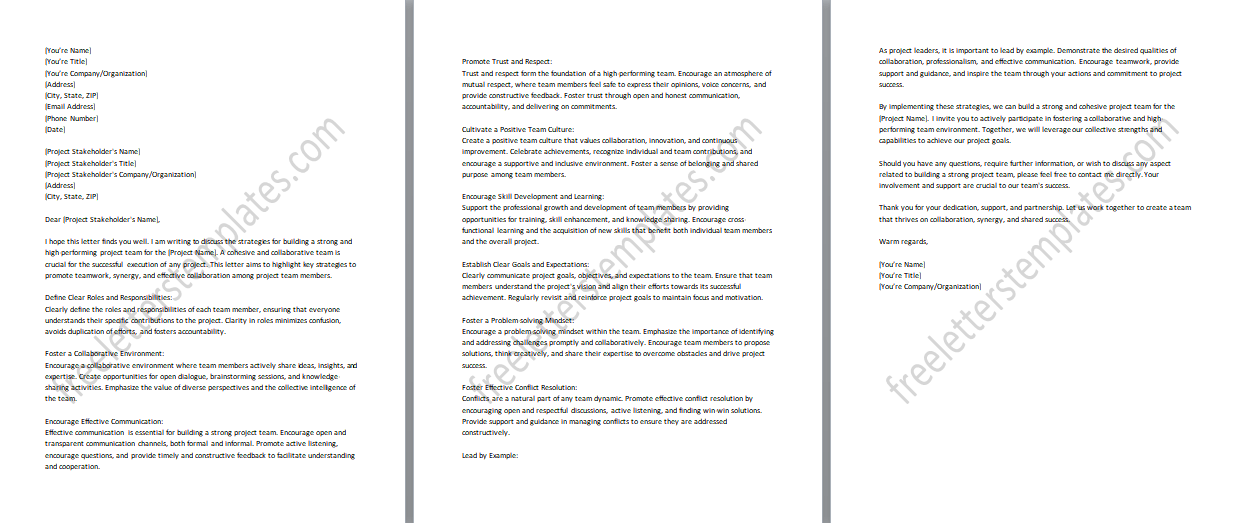
#22: Engaging Project Stakeholders:
A letter emphasizing the engagement of project stakeholders, discussing their roles, and soliciting their ongoing support and involvement. The Engaging Project Stakeholders letter emphasizes the importance of actively involving project stakeholders and discusses their crucial roles in the project’s success. It highlights the value of their insights, expertise, and support in decision-making processes and aligning the project with organizational goals. The letter seeks to foster strong stakeholder engagement by clarifying their roles, responsibilities, and expectations, while also soliciting their ongoing support and involvement. By emphasizing stakeholder engagement, the letter aims to create a collaborative and inclusive project environment that maximizes stakeholder contributions, enhances project outcomes, and strengthens stakeholder relationships.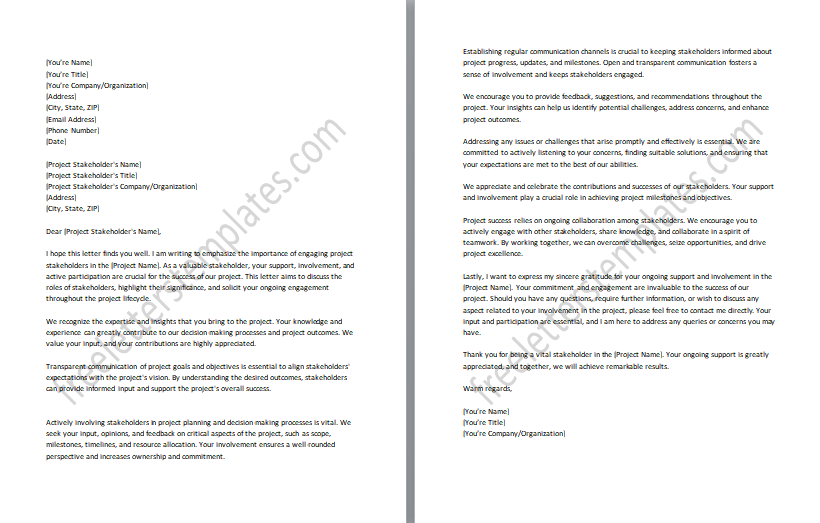
#23: Nurturing Project Collaboration:
A letter highlighting the significance of collaboration within the project team, sharing success stories, and fostering a collaborative culture. The Nurturing Project Collaboration letter emphasizes the significance of collaboration within the project team and aims to foster a collaborative culture.
It highlights the benefits of collaboration, such as improved communication, increased creativity, and enhanced problem-solving capabilities. The letter shares success stories and examples that showcase the positive outcomes achieved through collaboration. It encourages team members to actively engage in collaborative efforts, appreciate diverse perspectives, promote open dialogue, and leverage each other’s strengths. By nurturing project collaboration, the letter seeks to create a supportive and collaborative environment that enhances teamwork, productivity and ultimately contributes to the project’s success.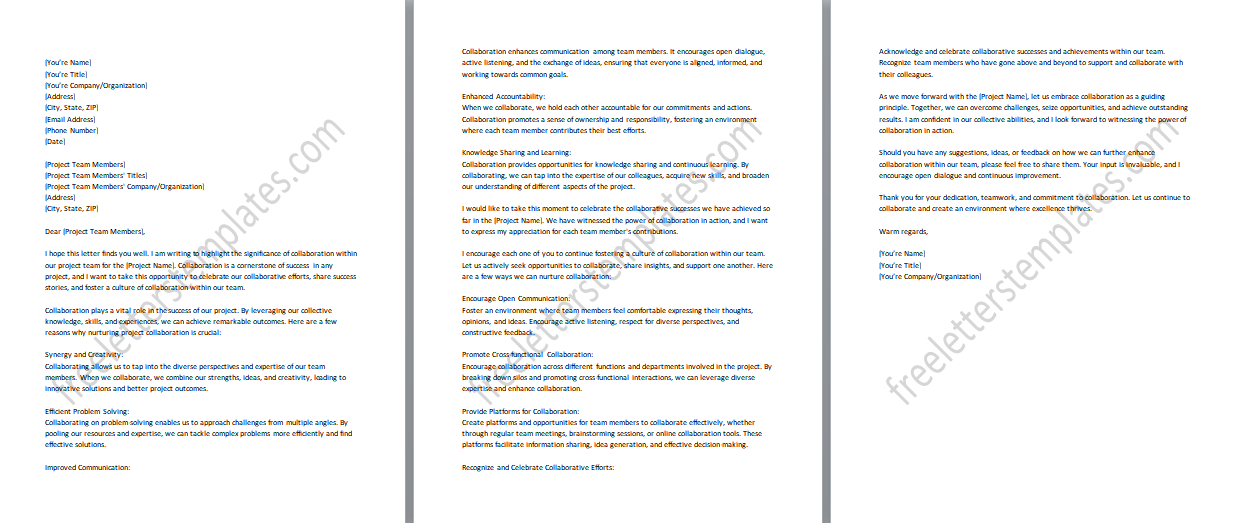
#24: Client Satisfaction Follow-up for the Project:
A letter seeking feedback from the client regarding their satisfaction with the project, addressing any concerns, and maintaining a positive client relationship. The Client Satisfaction Follow-up for the Project letter focuses on seeking feedback from the client to gauge their satisfaction with the project and to address any concerns they may have. It emphasizes the importance of maintaining a positive client relationship by actively seeking their input and ensuring their needs and expectations are met.
The letter highlights the significance of open communication, addressing any potential issues or challenges, and providing solutions or improvements when necessary. By seeking client feedback and addressing their concerns, the letter aims to strengthen the client relationship, build trust, and ensure a successful and satisfying project experience.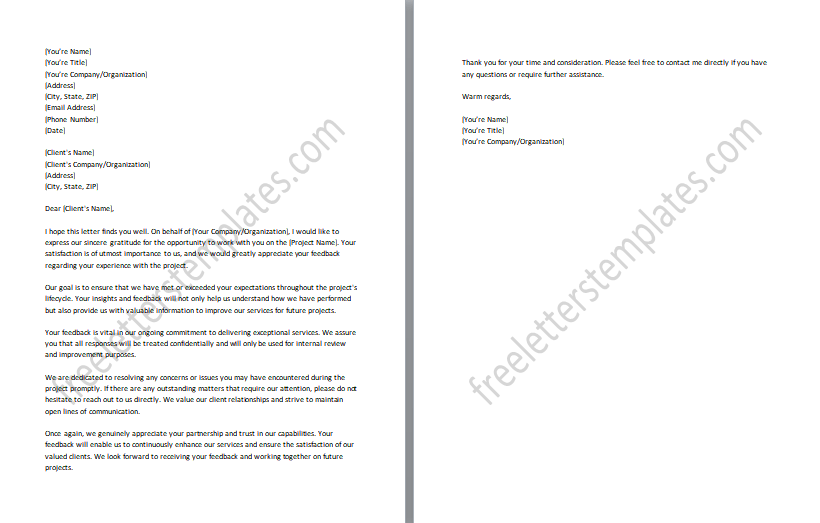
#25: Vendor Relationship Evaluation for the Project:
A letter evaluating the relationship with project vendors, discussing their performance, and addressing any areas for improvement. The Vendor Relationship Evaluation for the Project letter focuses on evaluating the relationship with project vendors, assessing their performance, and identifying areas for improvement. It emphasizes the importance of maintaining strong vendor relationships to ensure the successful delivery of the project. The letter discusses the performance of the vendors, including their adherence to timelines, quality of deliverables, and level of communication. It also addresses any areas for improvement, such as enhancing collaboration, resolving issues promptly, or exploring opportunities for cost optimization. By conducting a comprehensive evaluation and addressing areas for improvement, the letter aims to strengthen the vendor relationship, foster mutual success, and ensure the project’s overall success.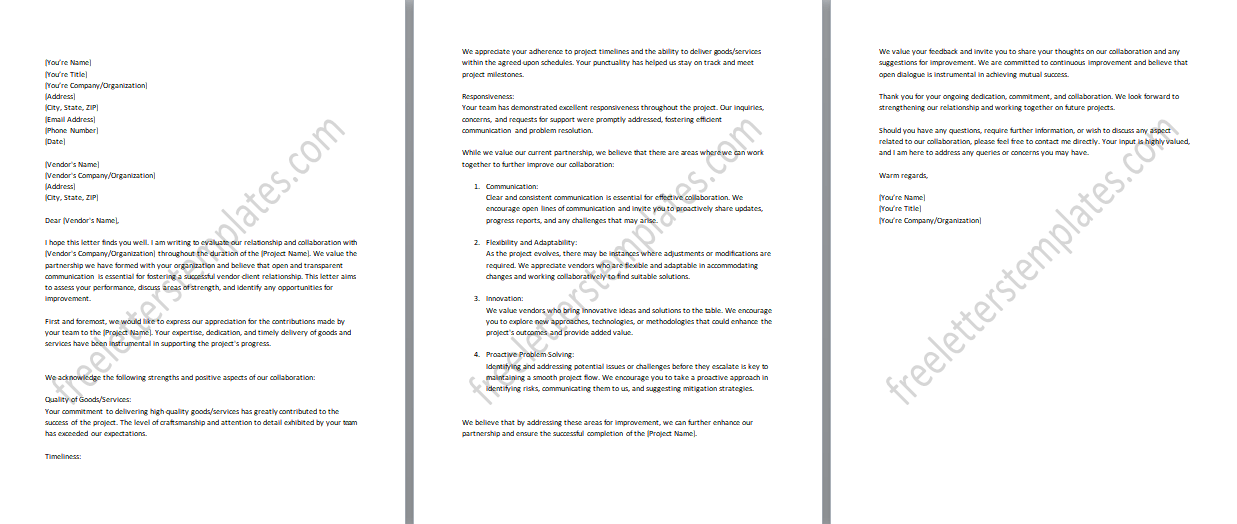
#26: Contract Review for the Project:
A letter reviewing the project contract, ensuring compliance, discussing any modifications, and addressing contractual matters. The Contract Review for the Project letter focuses on reviewing the project contract, ensuring compliance, discussing any necessary modifications, and addressing contractual matters. It emphasizes the importance of reviewing and upholding contractual obligations to maintain a mutually beneficial and transparent relationship between the parties involved. The letter addresses any potential deviations from the contract, proposes modifications if required, and seeks to resolve any contractual issues or concerns promptly.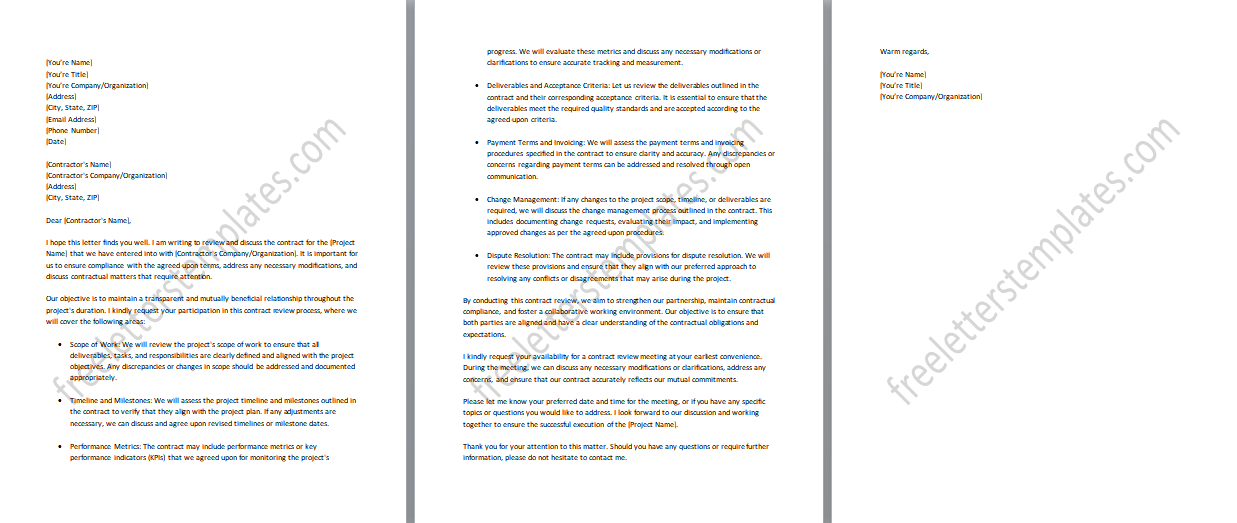
#27: Meeting Minutes and Project Follow-up:
A letter summarizing the minutes of a project meeting, highlighting action items, and providing updates or follow-up information. The Meeting Minutes and Project Follow-up letter serve as a concise summary of the minutes from a project meeting, emphasizing key discussion points, and action items, and providing relevant updates or follow-up information. It highlights the importance of effective communication and documentation in project management. The letter provides a clear record of the meeting outcomes, including decisions made, tasks assigned, and any important deadlines or milestones.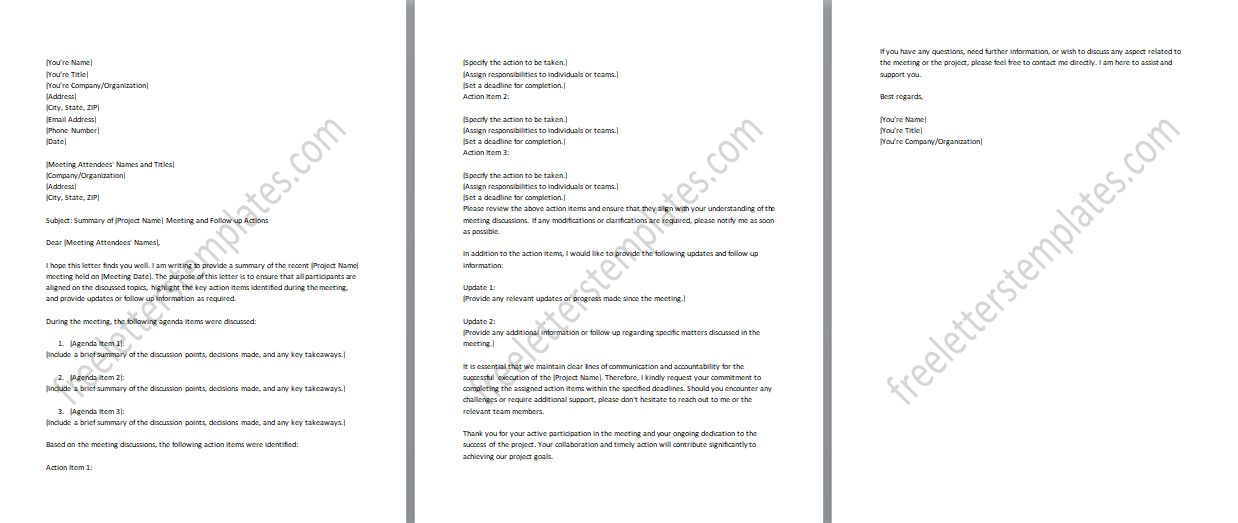
#28: Project Update and Progress Report:
A letter providing a comprehensive update on the project’s progress, including achievements, challenges, and plans. The Project Update and Progress Report letter serves as a comprehensive overview of the project’s status, accomplishments, challenges, and future plans. The letter highlights key achievements, discusses any challenges or obstacles faced, and outlines the planned steps for the project’s future development. By offering a clear and concise project update, the letter ensures transparency, encourages collaboration, and allows stakeholders to stay informed and aligned with the project’s goals and objectives.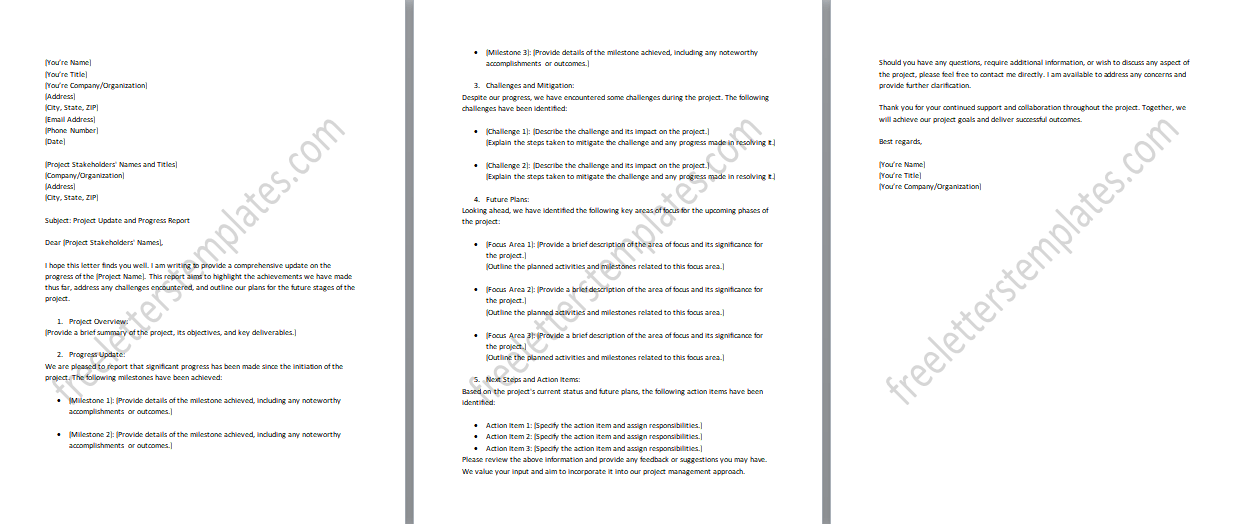
#29: Final Project Closure and Assessment:
A letter marking the official closure of the project, expressing gratitude, and conducting a final assessment of the project’s success and outcomes. The Final Project Closure and Assessment letter signifies the official closure of the project and serves as a final reflection on its success and outcomes. It also includes a comprehensive assessment of the project, highlighting its achievements, challenges overcome, and lessons learned. By conducting a final evaluation, the letter aims to gather insights and recommendations for future projects. It serves as a formal acknowledgment of the project’s completion while fostering a sense of closure and celebration among the project team and stakeholders.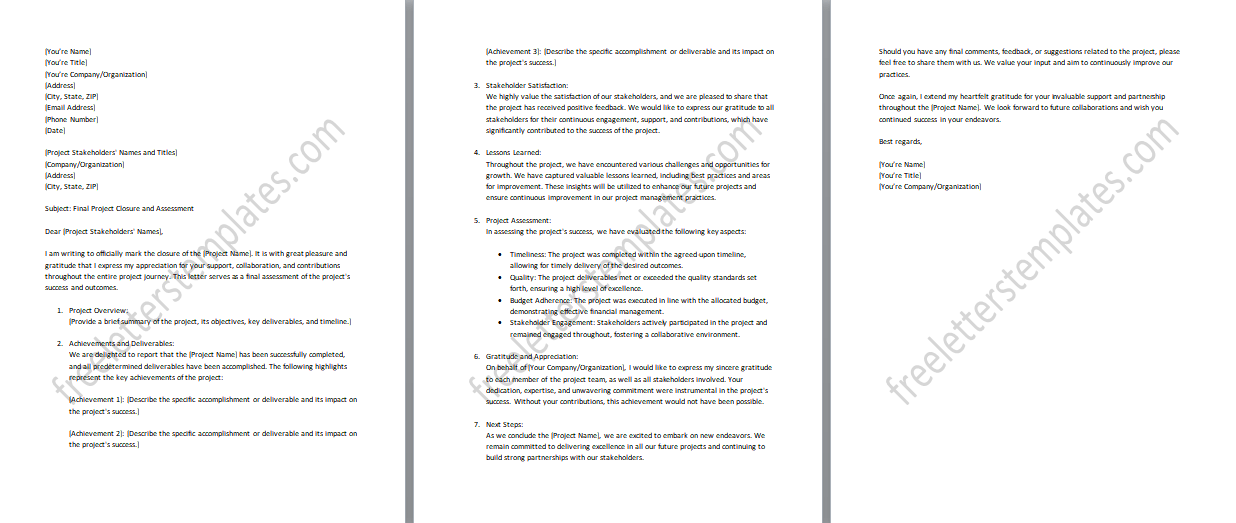
#30: Expressing Gratitude for the Project:
A letter expressing gratitude to all project stakeholders for their contributions, support, and collaboration throughout the project’s lifecycle. The Expressing Gratitude for the Project letter is a heartfelt message aimed at expressing sincere appreciation to all project stakeholders for their invaluable contributions, unwavering support, and collaborative efforts throughout the project’s lifecycle. The letter serves as a genuine expression of gratitude, acknowledging the dedication, expertise, and commitment demonstrated by each stakeholder. By summarizing the collective impact and emphasizing the importance of their involvement, this letter aims to foster positive relationships, strengthen partnerships, and recognize the significant role played by each individual in the project’s success.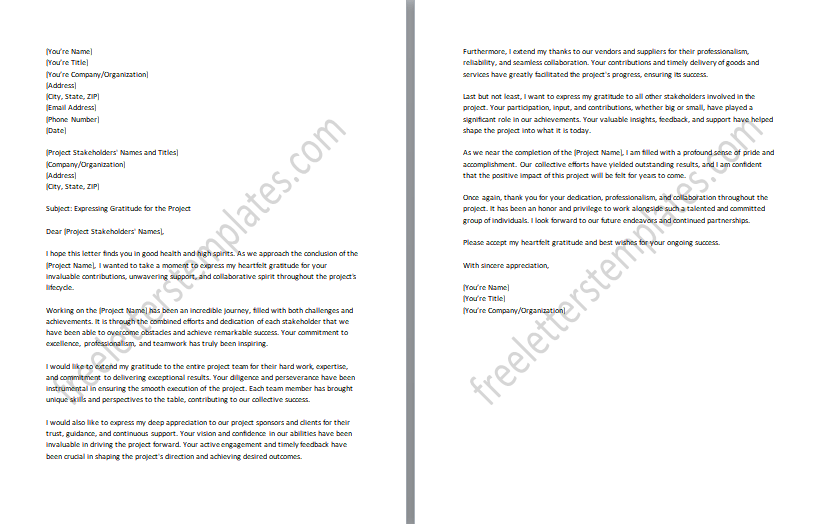
Project Documentation and Archiving
Proper documentation and archiving of project files refer to the systematic process of organizing and storing project-related documents, data, and information in a structured manner. The purpose is to ensure that project information is easily accessible and retrievable in the future, even after the project has been completed.
Here are some key aspects to consider when providing guidance on project documentation and archiving:
- Folder Structure: Define a consistent folder structure that organizes project documents and files logically. This structure may include folders for project plans, deliverables, communications, contracts, financial records, meeting minutes, and any other relevant categories.
- Naming Conventions: Establish clear and consistent naming conventions for files to facilitate easy identification and retrieval. Consider using a combination of project name, date, and brief description in the file names.
- Version Control: Emphasize the importance of version control to avoid confusion and ensure that the most up-to-date versions of documents are used. Encourage stakeholders to use version control techniques such as file naming conventions (e.g., v1, v2) or version control software.
- Document Metadata: Encourage the use of metadata, such as document properties or tags, to provide additional context and make it easier to search and filter project files based on specific criteria.
- Storage and Backup: Determine a secure and reliable storage solution for project files, whether it be a shared network drive, cloud-based storage platform, or document management system. Establish regular backup procedures to prevent data loss.
- Access Permissions: Define access permissions for project files based on the roles and responsibilities of stakeholders. Ensure that only authorized individuals have access to sensitive or confidential information.
- Retention Period: Specify the recommended retention period for project documents based on legal, regulatory, or organizational requirements. Identify which documents should be retained for future reference or auditing purposes.
- Document Index or Register: Consider creating a document index or register that provides an overview of all project documents, their locations, and relevant details. This index can serve as a quick reference point for stakeholders to locate specific documents.
Project Communication and Reporting
Project Communication and Reporting is a crucial elements in project follow-up letters. It involves establishing effective communication channels and processes to keep stakeholders informed about project developments and milestones. A robust communication plan should be developed from the project’s inception, outlining the channels, frequency of updates, and stakeholders to be included in each communication. Regular project updates, progress reports, and milestone notifications should be scheduled to provide stakeholders with a clear understanding of the project’s status and progress.
To ensure effective communication, it is important to choose suitable channels based on stakeholders’ preferences and needs. This may include email updates, project management software platforms, virtual meetings, or regular progress reports. Tailoring the information shared to suit each stakeholder’s level of involvement and interest in the project is essential. Clear and concise messaging will help stakeholders stay informed and engaged. Moreover, key milestones, project achievements, and any significant changes or challenges should be communicated promptly. Celebrating successes and addressing concerns transparently helps to maintain stakeholder support.
Regular project reporting plays a vital role in project communication. Comprehensive progress reports should be prepared, highlighting achieved milestones, deliverables, budget utilization, and any risks or issues encountered. These reports should provide data-driven insights and analysis, enabling stakeholders to make informed decisions. By establishing transparent communication channels, adhering to regular reporting schedules, and sharing timely updates, you can enhance stakeholder satisfaction and promote a positive project environment. Effective project communication and reporting foster transparency, trust, and collaboration among stakeholders, contributing to the overall success of the project.
Conclusion:
In conclusion, project follow-up letters are essential tools for maintaining effective communication, monitoring progress, and fostering stakeholder engagement throughout the project lifecycle. These letters serve as a means to provide updates, address concerns, and gather valuable feedback from project stakeholders. By utilizing well-crafted follow-up letters, project managers can ensure transparency, promote collaboration, and address any challenges or changes that arise during the project. Whether it’s acknowledging project milestones, assessing risks, expressing gratitude, or recommending improvements, each follow-up letter serves a specific purpose in driving project success. By incorporating these best practices and guidelines, project managers can effectively communicate and manage projects, resulting in increased stakeholder satisfaction and successful project outcomes.